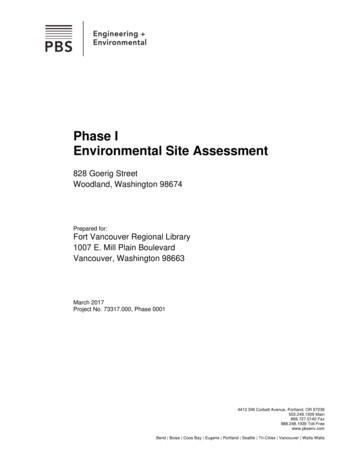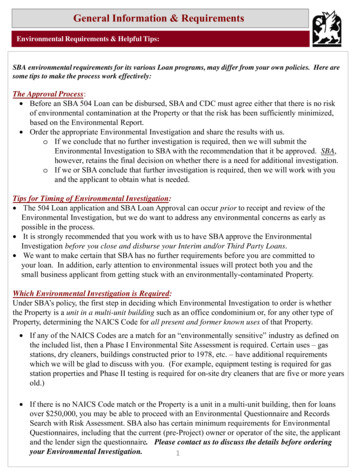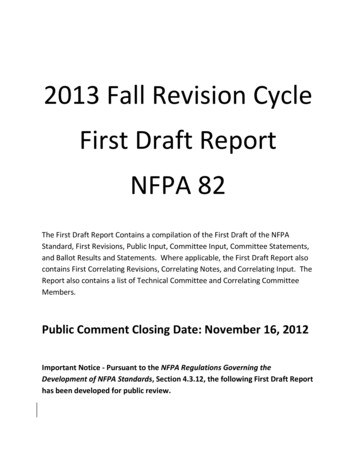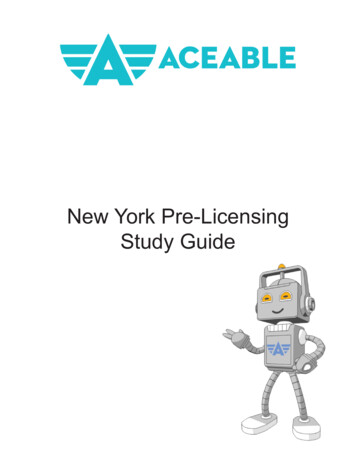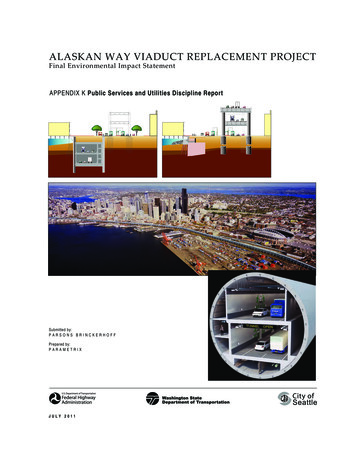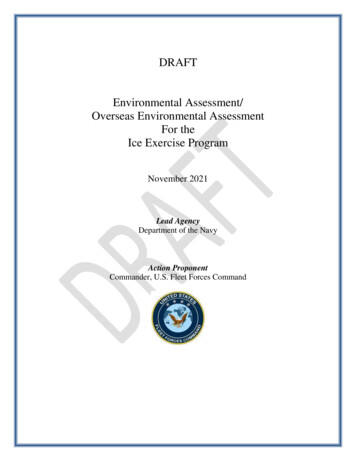
Transcription
DRAFTEnvironmental Assessment/Overseas Environmental AssessmentFor theIce Exercise ProgramNovember 2021Lead AgencyDepartment of the NavyAction ProponentCommander, U.S. Fleet Forces Command
Environmental Assessment/Overseas Environmental AssessmentThe Ice Exercise ProgramNovember 2021Page i1ENVIRONMENTAL ASSESSMENT/OVERSEAS ENVIRONMENTAL ASSESSMENT2FOR THE ICE EXERCISE PROGRAM3Lead Agency: Department of the Navy4Cooperating Agency: None5Title of the Proposed Action: The Ice Exercise Program6Designation: Final7ABSTRACT89101112The United States Department of the Navy prepared this Environmental Assessment(EA)/Overseas Environmental Assessment (OEA) in compliance with the NationalEnvironmental Policy Act (NEPA) and Executive Order (EO) 12114, Department of Defenseregulations found at 32 Code of Federal Regulations Part 187, and the Chief of Naval OperationsInstruction 5090.1 and its accompanying manual (M-5090).1314151617181920212223242526This EA/OEA evaluates the potential impact to the environment from the Ice Exercise (ICEX)Program. The need for the Proposed Action is to prepare forces capable of extended operationsand warfighting in the Arctic in accordance with Title 10 U.S.C. § 8062, and to support the aimsof the Arctic Research and Policy Act (15 United States Code §§ 4101 et seq.). The purpose ofthe Navy’s Proposed Action is to conduct realistic training and testing in an Arctic environment,and if resources are available, to gather data on environmental conditions and technologysuitability in an Arctic environment. This EA/OEA evaluates the following alternatives: the NoAction Alternative; Alternative 1 would conduct an ICEX (submarine testing and training withthe inclusion of research activities and construction of a support camp) biennially but noconstruction of a Beta camp during years in which an ICEX is not conducted; and Alternative 2an ICEX (submarine testing and training with the inclusion of research activities andconstruction of a support camp) would be conducted biennially, and a Beta camp would beconstructed either on an ice floe or in Deadhorse, Alaska during years in which an ICEX is notconducted.27282930In this EA/OEA, the Navy analyzed potential impact to the environment that could result fromthe No Action Alternative and two Action Alternatives. The resources evaluated include marinehabitats, marine invertebrates, marine birds, fish, Essential Fish Habitat, and mammals (marineand terrestrial).31Prepared by: United States Department of the Navy32333435Point of Contact:Ms. Laura BuschNatural Resources Program Manager1562 Mitscher Avenue, Suite 250Norfolk, Virginia 23551-2487
Environmental Assessment/Overseas Environmental AssessmentThe Ice Exercise Program1Executive Summary2PROPOSED ACTIONNovember 2021Page 031323334The Navy’s Proposed Action is to conduct submarine training and testing activities, whichincludes the establishment of a tracking range and temporary ice camp, and conduct research inan Arctic environment. The submarine and tracking range activities would be conductedbiennially, but a temporary ice camp would be established annually, either in the ice camp studyarea (Figure 2-1) or on a frozen lake in Deadhorse, Alaska. The purpose of the Navy’s ProposedAction is to evaluate the employment and tactics of submarine operability in Arctic conditions.The Navy’s Proposed Action would also evaluate emerging technologies and assess capabilitiesin the Arctic environment, and gather data on Arctic environmental conditions. Some of thesubmarine training and testing may occur throughout the deep Arctic Ocean basin near the NorthPole, within the Study Area (Figure 2-1). If Beta camps are constructed, that would occur duringyears in which an ICEX is not conducted to support the expeditionary testing and evaluation ofArctic equipment, and would involve fewer personnel and be shorter in duration that campsconstructed during years in which an ICEX is conducted. The Navy’s proposed action is neededbecause the United States (U.S.) needs submarines to continue to train in the Arctic to refine andvalidate procedures and required equipment, as the Arctic Ocean serves as a route for submarinesto transit between the Atlantic and Pacific Oceans. In addition to the primary objective ofsubmarine training and testing, military and academic institutions collaterally benefit from theuse of the ice camp to test new systems and conduct data collection and research in and about theArctic environment. The purpose of this Environmental Assessment (EA)/OverseasEnvironmental Assessment (OEA) is to assess the environmental effects of the Ice Exercise(ICEX program) including the construction of a camp on an ice floe to support the submarinetraining and testing, and construction of beta camps.35ALTERNATIVES3637383940414243For this EA/OEA, three alternatives were analyzed: the No Action Alternative and two ActionAlternatives. Under the No Action Alternative, ICEXs would not be conducted biennially, Betacamps would not be constructed in the alternate years, and NMFS would not issue an IHA underthe MMPA. Alternative 1 would conduct an ICEX (submarine testing and training with theinclusion of research activities) biennially with no Beta camp constructed during the alternateyears, and under Alternative 2 an ICEX would be conducted biennially, with the Beta campconstructed on the alternate years (when there is no ICEX), either on an ice floe or in Deadhorse,Alaska. NMFS’ Action Alternative is to issue one-year IHAs under the MMPA that wouldThe National Marine Fisheries Service’s (NMFS) proposed action is to issue one-year incidentalharassment authorizations (IHAs) pursuant to the Marine Mammal Protection Act (MMPA) toauthorize the non-intentional harassment of marine mammal species and stocks incidental to theNavy’s testing and training activities, if all required findings and determinations can be made.The purpose of NMFS’ proposed action is to evaluate the Navy’s proposed action pursuant to therequirements of the MMPA and make a determination of whether an IHA should be issued andany mitigation, monitoring, and reporting measures that should be included. The need forNMFS’ proposed action is to consider the impacts of the Navy’s activities on marine mammalsand meet NMFS’ obligations under the MMPA.
Environmental Assessment/Overseas Environmental AssessmentThe Ice Exercise ProgramNovember 2021Page iii1234authorize the incidental, but not intentional, harassment of marine mammal species or stocks thatis caused by the Navy’s activities, provided that all required findings and determinations underthe MMPA can be made.5ENVIRONMENTAL CONSEQUENCES67891011121314Potential environmental stressors include acoustic stressors (acoustic transmissions, aircraftnoise, and on-ice vehicle noise), physical stressors (aircraft, on-ice, and in-water vessel/vehiclestrike, and human presence), and stressors associated with expended material (bottomdisturbance, combustive byproducts, entanglement, and ingestion). The potential environmentalconsequences of these stressors have been analyzed in this EA/OEA for resources associatedwith the natural, physical, and socioeconomic environments. Quantitative analysis wasperformed on those resources, namely marine mammals, for which numerical impact thresholdshave been established. For those resources for which no thresholds have been established orappropriate information was not available, a qualitative approach was used.151617181920212223242526272829303132Under section 7 of the Endangered Species Act (ESA), the Navy requested initiation of informalconsultation with the U.S. Fish and Wildlife Service (USFWS) for the polar bear. USFWSconcurred on XX, 2021, with the Navy’s finding that the Proposed Action may affect, but is notlikely to adversely affect, polar bears (Ursus maritimus). A formal consultation, under section 7of the ESA, was requested for the ringed seal and bearded seal with NMFS. In accordance withthe MMPA, an application for an IHA was prepared for the harassment of marine mammals(ringed seals and bearded seals) incidental to active acoustic transmissions, and submitted toNMFS on August 26, 2021. If NMFS determines that all requirements have been met, it willpublish a notice of a proposed IHA in the Federal Register for public comment. In addition, anintentional take permit (for the active deterrence of polar bears) under the MMPA was obtainedfrom the USFWS on xx, 2021. The Navy completed Essential Fish Habitat consultation withNMFS for the previous ICEX (in 2016), in accordance with the Magnuson-Stevens FisheryConservation and Management Act. Since NMFS determined that the Proposed Action wouldnot likely effect Essential Fish Habitat and no conservation recommendations were provided,consultation was not reinitiated for the ICEX in 2018, 2020, or this ICEX. Finally, the Navyreceived a National Pollutant Discharge Elimination System permit from the EnvironmentalProtection Agency for the discharge of graywater and reverse osmosis reject water from the icecamp into the Beaufort Sea.333435The results of the analysis indicate that, with the implementation of standard operatingprocedures and mitigation measures, neither of the two Action Alternatives would significantlyimpact the natural and physical environments.
Environmental Assessment/Overseas Environmental AssessmentThe Ice Exercise Program12Chapter 1November 2021Page ivTable of ContentsPurpose and Need . 1-131.1Introduction . 1-141.2Purpose and Need . 1-151.3Applicable Laws and Directives . 1-261.3.1National Environmental Policy Act (NEPA) . 1-271.3.2Executive Order 12114 . 1-281.3.3Arctic Research and Policy Act . 1-391.3.4Clean Water Act . 1-4101.3.5Endangered Species Act . 1-4111.3.6Marine Mammal Protection Act . 1-4121.3.7Magnuson-Stevens Fishery Conservation and Management Act . 1-6131.3.8Migratory Bird Treaty Act . 1-714Chapter 2Proposed Action and Alternatives . 2-1152.1Proposed Action . 2-1162.1.1Ice Camp . 2-3172.1.2Beta Camp . 2-6182.1.3Prudhoe Bay . 2-6192.1.4Submarine Training and Testing . 2-7202.1.5Research Activities . 2-7212.2Platform Descriptions . 2-9222.2.1On-Ice Vehicles . 2-9232.2.2Aircraft . 2-10242.2.3Unmanned Underwater Vehicles and Systems . 2-11252.2.4Scientific Devices . 2-13262.2.4.1Passive Devices . 2-13272.2.4.2Active Acoustic Devices . 2-14282.3Alternatives . 2-14292.3.130312.3.2Alternative 1: ICEX events (supporting submarine testing and training) conductedbiennially with torpedo exercise every four years. . 2-1532332.3.3Alternative 2: ICEX events conducted biennially with a Beta camp constructedeither on ice floe or in Deadhorse, Alaska annually. . 2-15342.3.4352.4No Action Alternative . 2-15Alternatives Eliminated from Further Consideration . 2-16Resource Analysis . 2-16
Environmental Assessment/Overseas Environmental AssessmentThe Ice Exercise Program12Chapter 33.1November 2021Page vExisting Environment . 3-1Physical Environment . 3-133.1.1Water Quality . 3-143.1.2Air Quality and Greenhouse Gases . 3-153.1.2.1Greenhouse Gases. 3-263.1.2.2Affected Environment . 3-373.1.3Sea Ice . 3-383.1.3.1Arctic Sea Ice Regime . 3-393.1.3.2Sea Ice Extent . 3-310113.23.2.11213Biological Environment . 3-73.2.1.13.2.2Invertebrates . 3-7Invertebrate Hearing . 3-8Marine Birds . 3-9143.2.2.1Major Bird Groups. 3-9153.2.2.2Hearing . 3-9163.2.3Fish . 3-10173.2.3.1Major Fish Groups . 3-10183.2.3.2Hearing . 3-10193.2.4Essential Fish Habitat . 3-11203.2.5Mammals. 3-14213.3Socioeconomic Environment . 3-24223.3.1Subsistence Hunting. 3-2423Chapter 4Environmental Consequences . 4-124254.1Acoustic Stressors . 4-14.1.1Acoustic Transmissions . 4-1264.1.1.1Invertebrates . 4-3274.1.1.2Fish . 4-3284.1.1.3Essential Fish Habitat . 4-5294.1.1.4Mammals (Marine) . 4-5304.1.2Aircraft Noise. 4-10314.1.2.1Marine Birds . 4-14324.1.2.2Mammals (Marine and Terrestrial). 4-1633344.1.34.1.3.1On-Ice Vehicle Noise . 4-19Marine Birds . 4-20
Environmental Assessment/Overseas Environmental AssessmentThe Ice Exercise Program124.1.3.24.2November 2021Page viMammals (Marine and Terrestrial). 4-20Physical Stressors . 4-2334.2.1Aircraft Strike . 4-2344.2.2On-Ice Vehicle Strike . 4-2454.2.3In-Water Vessel and Vehicle Strike . 4-2664.2.3.1Invertebrates . 4-2774.2.3.2Fish . 4-2884.2.3.3Mammals (Marine) . 4-2894.2.4Human Presence. 4-29104.2.4.1Marine Habitats (Water Quality) . 4-31114.2.4.2Essential Fish Habitat . 4-32124.2.4.3Mammals (Marine and Terrestrial). 4-3313144.3Expended Materials . 4-374.3.1Combustive Byproducts . 4-37154.3.1.1Marine Habitat . 4-38164.3.1.2Invertebrates . 4-38174.3.1.3Fish . 4-39184.3.1.4Essential Fish Habitat . 4-39194.3.1.5Marine Mammals . 4-40204.3.2Entanglement . 4-40214.3.2.1Invertebrates . 4-40224.3.2.2Fish . 4-41234.3.2.3Mammals (Marine) . 4-4224254.4Summary of Analysis . 4-42Chapter 5Cumulative impacts . 5-1265.1Definition of Cumulative Impacts . 5-1275.2Scope of the Cumulative Impact Analysis . 5-2285.2.1Past, Present, and Reasonably Foreseeable Future Actions . 5-229Chapter 6Standard Operating Procedures and Mitigation Measures . 6-1306.1Standard Operating Procedures . 6-1316.2Mitigation Measures . 6-132Appendix AClean Water Act Permit . A-133Appendix BEndangered Species Act Consultations .B-134Appendix CMarine Mammal Protection Act Permits.C-1
Environmental Assessment/Overseas Environmental AssessmentThe Ice Exercise ProgramNovember 2021Page vii1Appendix DSubmarine Training and Testing Activities. D-12Appendix EStressor Matrices . E-13Appendix FAcoustic Modeling . F-14Appendix GPreparers . G-15Appendix HReferences . 13233343536373839404142434445List of FiguresFigure 2-1. The ICEX Program Study Area . 2-2Figure 2-2. Potential Beta Camp Locations . 2-3Figure 2-3. Example Ice Camp . 2-4Figure 2-4. Typical On-Ice Vehicles (e.g. snowmobiles) used during ICEX . 2-9Figure 2-5. All-Terrain Tracked Vehicle . 2-10Figure 2-6. Typical Aircraft used during ICEX . 2-10Figure 2-7. Military Aircraft used during an ICEX Event . 2-11Figure 2-8. Example Unmanned Underwater Vehicles . 2-12Figure 2-9. Example Fixed-wing Unmanned Aerial System . 2-12Figure 2-10. Example Rotary-wing Unmanned Aerial Systems . 2-13Figure 2-11. Example Passive Devices (Buoys) . 2-14Figure 3-1. Average Arctic Sea Ice Extent in March. 3-5Figure 3-2. Average Arctic Sea Ice Extent for March (1979-20121 . 3-7Figure 3-3. Essential Fish Habitat for Arctic Cod . 3-13Figure 3-4. Proposed Critical Habitat for Bearded Seals . 3-15Figure 3-5. Ringed Seal Distribution in Study Area . 3-18Figure 3-6. Polar Bear At-Sea Distribution in Study Area . 3-22Figure 3-7. Subsistence Harvest Extent for Villages of Barrow, Kaktovik, and Nuiqsut . 3-27Figure 4-1. The Bayesian biphasic dose-response BRF for Pinnipeds. . 4-7Figure 4-2. Characteristics of Sound Transmission through the Air-Water Interface . 4-12Appendix Figure 6-1. The Bayesian biphasic dose-response BRF for Pinnipeds. . F-5List of TablesTable 2-1. Summary of Training and Testing and Research Activities . 2-8Table 2-2. Parameters of Scientific Devices with Active Acoustics . 2-14Table 2-3. Relevant Resources and Potential Effects of the Proposed Action . 2-17Table 2-4. Resources Eliminated from Analysis . 2-18Table 3-2. Taxonomic Groups of Marine Invertebrates in the Beaufort Sea. 3-8Table 3-3. Marine Bird Species that May Occur in the Study Area during the Proposed Action3-9Table 3-4. Major Groups of Marine Fish in the Study Area during the Proposed Action* . 3-10Table 3-5. Mammals Found in the Study Area during the Proposed Action . 3-14Table 4-1. In-Water Criteria and Thresholds for Predicting Physiological and Behavioral Effectson Marine Mammals Potentially Occurring in the Study Area . 4-6Table 4-2. Quantitative Modeling Results of Potential Exposures for 2022 ICEX Activities . 4-7Table 4-3. Source Levels of Representative Aircraft1 . 4-13Table 5-1. Recent Past, Present, and Reasonably Foreseeable Future Actions Within the Vicinityof the Study Area . 5-2
Environmental Assessment/Overseas Environmental AssessmentThe Ice Exercise Program12345678November 2021Page viiiAppendix TablesAppendix Table E-1. Stressors by Activity .E-2Appendix Table E-2. Stressors by Resource.E-3Appendix Table F-1. Environmental Parameters for ICEX. F-2Appendix Table F-2. Injury (PTS) and Disturbance (TTS, Behavioral) Thresholds forUnderwater Sounds.1. F-5Appendix Table F-3. Predicted Marine Mammal Exposures. . F-8
Environmental Assessment/Overseas Environmental AssessmentThe Ice Exercise Program1ºC FBOEMCEQCFRcmcm/sdB re 1 µPadB re 20 -Stevens EApsuPTSSASSELSPLTTSU.S.U.S.C.USEPAUSFWS2November 2021Page ixAcronyms and Abbreviationsdegrees Celsiusdegrees FahrenheitBureau of Ocean Energy ManagementCouncil on Environmental QualityCode of Federal Regulationscentimeter(s)centimeters per seconddecibel(s) referenced to 1 micropascaldecibel(s) referenced to 20 micropascalA-weighted sound levelsEnvironmental AssessmentExpendable Mobile Anti-Submarine Warfare Training TargetsExecutive OrderEndangered Species ActGreenhouse gasesHertzIce ExerciseIncidental Harassment Authorizationkilometer(s)kilometers squaredkilohertzpound(s)meter(s)Magnuson Stevens Fishery Conservation and Management ActMilligram(s) per gallonMarine Mammal Protection ActNational Ambient Air Quality StandardsNavy Acoustic Effects ModelUnited States Department of the NavyNational Environmental Policy Actnautical milesNational Marine Fisheries ServiceNavy Marine Species Density DatabaseOceanographic and Atmospheric Master LibraryOverseas Environmental Assessmentpractical salinity unitsPermanent Threshold ShiftSynthetic aperture sourceSound Exposure LevelSound Pressure LevelTemporary Threshold ShiftUnited StatesUnited States CodeUnited States Environmental Protection AgencyUnited States Fish and Wildlife Service
Environmental Assessment/Overseas Environmental AssessmentThe Ice Exercise ProgramNovember 2021Page 1-11CHAPTER 1PURPOSE AND NEED21.1345678The United States (U.S.) Department of the Navy (Navy) has maintained a presence in the Arcticregion for decades. Navy experience spans Admiral Byrd’s historic overflight of the North Polein 1926, various campaigns in World War II, consistent activity during the Cold War, andcombined exercises with surface, subsurface, aviation, and expeditionary forces today. While theArctic is not unfamiliar for the Navy, expanded capabilities and capacity are needed for the Navyto increase its engagement in this region.91011121314151617In 2012, Arctic sea ice reached its smallest yearly extent in r
21 (ringed seals and bearded seals) incidental to active acoustic transmissions, and submitted to 22 NMFS on August 26, 2021. If NMFS determines that all requirements have been met, it will 23 publish a notice of a proposed IHA in


